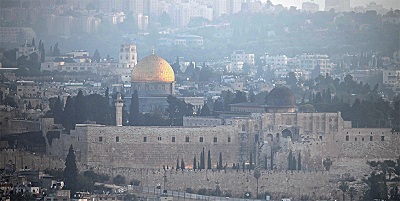US Arabs and Muslims for Jewish-Americans - By Walid Jawad, Alarabiya
The Arab and Muslim American communities have been resolute in their condemnation of the Pittsburg synagogue shooting. Not only in words, but also in action.
The Muslim-American community has raised $150,000 for the victims of the terrorist attack, while many Arab-Americans reached out to the Jewish community to offer a helping hand.
The question is why? Why would these communities come together in the US while their members feud around the world?
The US has been plagued with a history of chronic social imbalance starting with the first settlers, and their animosity toward the natives; otherwise known as Native Americans or Indians as they were mistakenly were thought to be by Christopher Columbus.
Not to be dismissive of Columbus’s daring voyage, the natives of the land have already discovered America before Columbus, which makes the claim of “discovering” a new world mute.
Moreover, naming this “New World’ after Amerigo Vespucci, the Italian explorer, who explored the new continents in the following years after Columbus, was unjustified and, undoubtedly, an offense to the natives.
ALSO READ: Rise of white supremacy and forgotten Arab-American victims
After the natives were marginalized through violent means, new dynamics arouse pitting the dominant white population against other minorities, chief among them the black slaves.
The overt structural imbalance ended with freeing the slaves, yet a subtle and covert prejudice continues. Although the discrimination is clear to see, it is not exclusively against African-Americans, it’s against all minorities.
This reality makes all members of minority communities gravitate toward each other for self-preservation. These minorities are well aware that their ability to push against any structural inequality lies in effective collaboration between them.
The Muslim and Jewish communities are but two of those communities that have been on the receiving end of some of the structural prejudice. Over the years Muslims and Jewish Americans have come together in solidarity knowing that together they are much better able to defend their own communities while apart they are more vulnerable.
A minority-majority nation
Throughout, White America was the majority; now the “minority-majority” is turning the paradigm onto its head – this midterm election is a testament to that. As it stands today, whites are a minority in five states.
California, Hawaii, Nevada, New Mexico, and Texas is composed of a minority population surpassing 50 percent of the total number of its residents and by definition, these minority groups together are more in numbers than white residents; i.e. forming a minority-majority.
Further, the white population in another seven states is dwindling to 6 in ten people. Among eight; Arizona, Florida, Georgia, Louisiana, Mississippi, New Jersey, New York, the state of Maryland is at the cusp of becoming a minority dominant state as of 2017.
In total, a quarter of the 50 US States is becoming a minority-majority states while it is predicted that by 2045 no one group will form a majority. Accepting more migrants might speed up the process, but it will happen nevertheless.
ALSO READ: Balancing development dollars with humanitarian assistance
If white politicians are concerned with their dominant status, then they should move on establishing a more equitable society rather than quell the flow of migrants. The outcome of a minority-majority is inevitable!
US territories are all minority-majority as they never were dominated by whites. Let us be clear, the distinction of white majority is even more complex than it sounds. One of the most interesting aspects of this distinction is that Arabs and Jews are officially considered whites, creating a subset within the white classification.
It would have been probably a better distinction to use the geographical identifier of “Caucasian” than that of the color “white.” Caucasian referred to people who hailed from Europe, the greater Middle East, North Africa, and the Horn of Africa.
In the 1990s, the courts ruled against re-designating an Arab-American plaintiff from “white” to “black” invoking his dark colored skin. This person, who is originally from Sudan, argued that because the distinction is made on a spectrum of color, he should be considered black due to his dark skin pigmentation. The courts relied on an ethnic distinction that defines Arabs as “white.”
Race politics
The reason why anyone would be concerned with the distinction is because minorities in the US enjoy varying degrees of social and/or financial advantages based on their specific designation.
It must be considered that, although the word minority is not exclusively based on ethnicity, color is a primary identifier. The US should synchronize its government benefit programs targeting disadvantaged minorities to be defined based on the type of benefit it offers.
If the benefit is financial, then the group should be defined in economic terms to meet income and purchasing power criteria. Such should be the case for the different programs that advance gender equality or people with medical maladies.
Even ethnic groups fleeing war should not be designated based on their ethnicity or national origin. Instead, they should be identified based on their status as “refugees.” Words do matter, in this case using the words white or black, Hispanic or any other non-white, frames the equation along ethnic and racial lines.
The benefits of having race-based dichotomy is less beneficial than one that describes a group’s practical status for the purpose of acknowledging and correcting an injustice or disadvantage befalling them.
ALSO READ: What Kavanaugh nomination tells us about American politics
Ethnic distinctions are flawed social constructs that lead to consequential political outcomes. Tuesday’s midterm elections has already offered insights for us to extrapolate a tide of changing social and political dynamics; color, gender, and ethnicity are some of the examples.
A possible blue wave, where Democratic candidates are expected to win enough races to regain control of the US House of Representatives, might be a reality. But relying only on race dynamic is not the best predictor. The “white majority,” which is deemed to be in support of Trump, in reality, is more fractured than it appears.
For Arabs and Jews to be considered white, suggest that the larger group is much weaker as a voting block and much more diverse than otherwise expected, limiting its political effectiveness at the ballot boxes.
Electoral finish line
Arab Americans, as well as Muslim Americans, have been enjoying a strong showing this election year. Not only as voting blocs but in the increasing number of promising candidates. There is an overlap between the two communities, specifically in that group that happens to be both Muslim and Arabs.
It is worth noting that the majority of the Muslim-American community is composed of non-Arab Muslims, while historically Arab-Americans have been predominantly Christian.
The latest influx of Arab refugees settling in the US over the past 30 years has balanced out the Arab-American community to be equal parts Christian as much as it is Muslim. The community’s Arabic heritage is a stronger denominator bringing the group together allowing them to overcome their religious differences.
This election result and the next presidential elections of 2020 will be revealing as to how the dynamic of race, ethnicity, and religion will shape the outcome.
Latest News
 King, Bahrain monarch stress need to maintain Arab coordination
King, Bahrain monarch stress need to maintain Arab coordination Security Council to vote Thursday on Palestinian state UN membership
Security Council to vote Thursday on Palestinian state UN membership Dubai reels from floods chaos after record rains
Dubai reels from floods chaos after record rains Khasawneh, Saudi Shura Council speaker discuss bilateral ties, regional developments
Khasawneh, Saudi Shura Council speaker discuss bilateral ties, regional developments Egyptian Foreign Minister condemns potential Palestinian displacement as 'war crime'
Egyptian Foreign Minister condemns potential Palestinian displacement as 'war crime'
Most Read Articles
- Senate president, British ambassador discuss strategic partnership, regional stability
- Jordan urges UN to recognise Palestine as state
- JAF carries out seven more airdrops of aid into Gaza
- Temperatures to near 40 degree mark next week in Jordan
- Safadi, Iranian counterpart discuss war on Gaza, regional escalation
- UN chief warns Mideast on brink of ‘full-scale regional conflict’
- US vetoes Security Council resolution on full Palestinian UN membership
- Google fires 28 employees for protesting $1.2 billion cloud deal with “Israeli” army
- Biden urges Congress to pass 'pivotal' Ukraine, Israel war aid
- Israeli Occupation strike inside Iran responds to Tehran's provocation, reports say